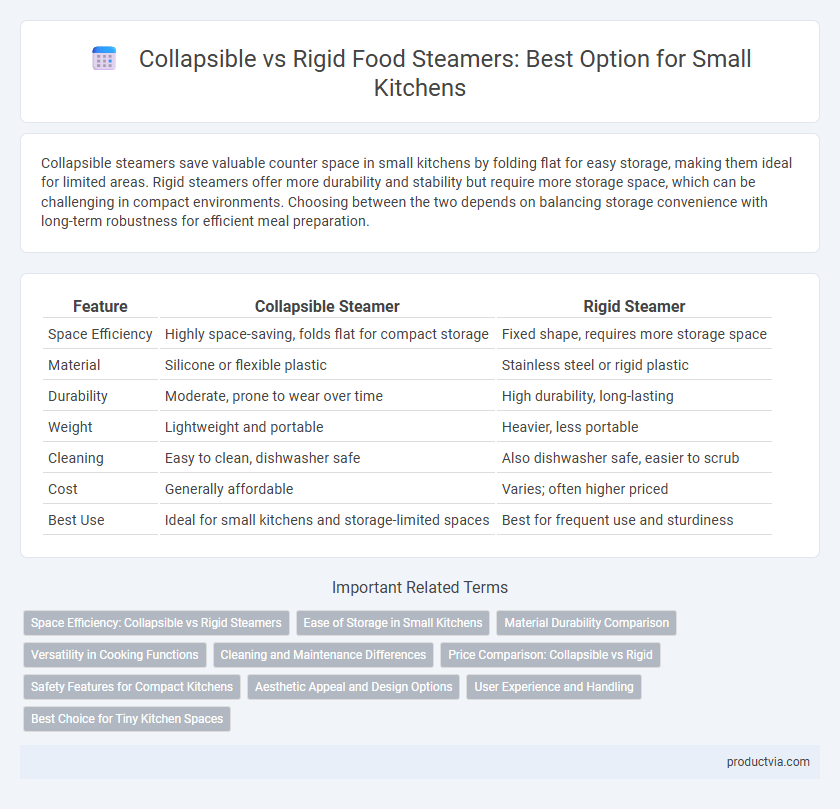Collapsible steamers save valuable counter space in small kitchens by folding flat for easy storage, making them ideal for limited areas. Rigid steamers offer more durability and stability but require more storage space, which can be challenging in compact environments. Choosing between the two depends on balancing storage convenience with long-term robustness for efficient meal preparation.
Table of Comparison
| Feature | Collapsible Steamer | Rigid Steamer |
|---|---|---|
| Space Efficiency | Highly space-saving, folds flat for compact storage | Fixed shape, requires more storage space |
| Material | Silicone or flexible plastic | Stainless steel or rigid plastic |
| Durability | Moderate, prone to wear over time | High durability, long-lasting |
| Weight | Lightweight and portable | Heavier, less portable |
| Cleaning | Easy to clean, dishwasher safe | Also dishwasher safe, easier to scrub |
| Cost | Generally affordable | Varies; often higher priced |
| Best Use | Ideal for small kitchens and storage-limited spaces | Best for frequent use and sturdiness |
Space Efficiency: Collapsible vs Rigid Steamers
Collapsible steamers offer superior space efficiency for small kitchens by folding down to a compact size, making storage in tight cabinets or drawers effortless. Rigid steamers maintain a fixed shape and often require dedicated storage space, which can be challenging in limited areas. Choosing a collapsible steamer maximizes countertop and storage flexibility without sacrificing steaming capacity.
Ease of Storage in Small Kitchens
Collapsible steamers offer significant space-saving advantages in small kitchens due to their ability to fold flat for easy storage in drawers or narrow cabinets. Rigid steamers, while typically more durable, require dedicated shelf space and can be cumbersome to store in tight environments. Opting for a collapsible design enhances kitchen organization by minimizing clutter without sacrificing steaming efficiency.
Material Durability Comparison
Collapsible steamers are typically made from silicone or BPA-free plastic, offering flexibility and space-saving advantages but generally lower durability compared to rigid steamers. Rigid steamers, constructed from stainless steel or heavy-duty aluminum, provide enhanced material strength and resistance to wear, making them more reliable for long-term use in small kitchens. Choosing between these options depends on balancing the need for compact storage with the importance of durable, heat-resistant materials.
Versatility in Cooking Functions
Collapsible steamers offer exceptional versatility in cooking functions by allowing adjustable capacity, making them ideal for steaming delicate vegetables, fish, and larger items in small kitchens. Rigid steamers provide consistent heat distribution with stable structure but lack the flexibility to expand or compress, limiting adaptability for diverse cooking tasks. For compact spaces, collapsible models maximize functionality without sacrificing storage efficiency, enhancing overall kitchen utility.
Cleaning and Maintenance Differences
Collapsible steamers feature foldable silicone or mesh layers that are dishwasher safe and easy to rinse, reducing cleaning time and effort in small kitchens. Rigid steamers, often made of stainless steel, require thorough hand washing and drying to prevent rust and maintain durability. Choosing a collapsible steamer enhances convenience with minimal upkeep, while rigid steamers demand more maintenance but offer long-term sturdiness.
Price Comparison: Collapsible vs Rigid
Collapsible steamers typically offer a more budget-friendly option for small kitchens, with prices ranging from $15 to $30, compared to rigid steamers that usually cost between $25 and $50. The lower price of collapsible steamers reflects their space-saving design and lightweight materials, making them ideal for limited storage. Rigid steamers, constructed with durable stainless steel or heavy-duty plastic, provide greater durability but often come at a higher price point.
Safety Features for Compact Kitchens
Collapsible steamers, made from flexible silicone or lightweight materials, offer enhanced safety by minimizing the risk of burns through easy handling and cool-touch surfaces, making them ideal for compact kitchens. Rigid steamers, often constructed with stainless steel, provide sturdy construction but may retain heat longer, increasing burn hazards in tight spaces. For small kitchens, choosing a collapsible steamer ensures safer storage and reduced accidental contact with hot surfaces, optimizing both safety and convenience.
Aesthetic Appeal and Design Options
Collapsible steamers offer a sleek and modern aesthetic with their flexible silicone structure, making them ideal for small kitchens seeking space-saving solutions without sacrificing style. Rigid steamers typically come in stainless steel or bamboo, providing a classic and sturdy appearance but with limited design variations compared to collapsible models. Choosing between the two depends on the balance between compact storage convenience and a preference for traditional or innovative design aesthetics.
User Experience and Handling
Collapsible steamers offer compact storage and easy handling, ideal for small kitchens where counter space is limited. Rigid steamers provide sturdy construction and often larger capacity but can be cumbersome to store and maneuver. Users prioritize collapsible steamers for their convenience and space-saving design, enhancing overall kitchen usability.
Best Choice for Tiny Kitchen Spaces
Collapsible steamers offer superior space-saving benefits compared to rigid steamers, making them the best choice for tiny kitchen spaces where countertop and storage room are limited. Their flexible silicone design allows for easy folding and compact storage, optimizing kitchen organization without sacrificing steaming capacity. In contrast, rigid steamers, while durable, often occupy significant space and can clutter small kitchens, reducing overall efficiency.
Collapsible steamer vs Rigid steamer for small kitchens Infographic

 productvia.com
productvia.com